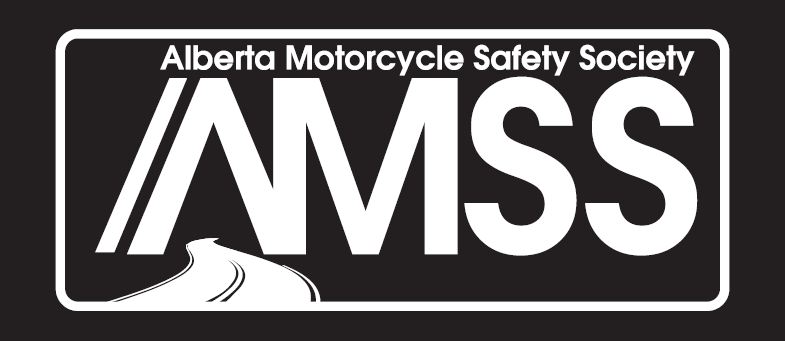Gear Toe to Head!
Proper Fit and Quality are Key!
By: Jon Watchuk
Pictures courtesy of Motovan via Cycle Works
The AMSS has always had a focus on good fitting, quality gear. As a last line of defense, when all else has gone sideways, gear may be the difference between walking away in disgust and being carted away on a stretcher. The key elements often mentioned are quality and fit, yet surprisingly for us the most important is not the quality, it is fit; not only having gear that is suited to your body type but also protection that is in the correct place to do its job when you're on your type of ride. If you're the kind of person that does not like to shop and try things on, this will be the hardest part, as good fit is time consuming and often frustrating. Patience pays off.
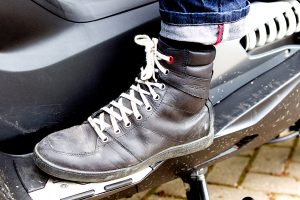
#Motovan
Starting at the bottom: boots. Personally I find boots some of the easiest to sort as I've been wearing good and bad shoes, hiking boots, work boots, and riding boots for a long time. It becomes apparent quickly what will not work; getting that pair of boots that will work does take more time. A little walking around, sitting on bikes similar to your own and generally putting them through the paces is needed to find out if they pinch, rub, or squeeze in a spot that will become trouble miles down the road. Good soles, toe, ankle, and above the ankle coverage and support is ideal. Whether your riding preference leads to more sporting boots with more external toe, ankle, and shin protection, or if you live in Alberta where the weather can change and waterproof footwear is needed is a matter personal taste. Design of the boot at the ankle should provide side impact, twist and flex, as well as abrasion protection. Coming off a bike may mean a foot being trapped under it while still moving, impact with the ground at speed, or tumbling down the road with appendages all akimbo. Not a pretty visual, but, that's what should be at the foot of your list.

#Motovan
Next, up with pants. Riding pant options are numerous, whether kevlar and armoured 'jeans', weather proof textile pants, or full leather lowers, all options have the same thing in mind; slide protection. Animal hide like leather or its lighter, more expensive companion kangaroo, slide on asphalt better than most anything else. Finding good fit, good coverage, and both at a reasonable price can be more difficult. It's also less forgiving if the weather becomes less than ideal without additional layers. Textile pants can be more weather practical, but waterproof can also mean hotter. Armoured 'jeans' may not have the slide protection of leather, or the weather protection of some textiles, but can be more comfortable and more conservatively styled than both. Sitting on a bike like yours is again key. If the pants leave a gap between the bottom of the coat and their top leading to the dreaded “plumber butt”, then sensitive parts are exposed to both the elements and abrasion. One of the first points of contact with the ground is almost always the gluteus maximus, make sure it's protected. Length should also make sure that if they're outside the boots they stay that way and don't ride up. Test sitting can also give an indication if seams will become annoying (underwear choices or bike shorts can also make a difference with this). Do these pants make my butt look fast?
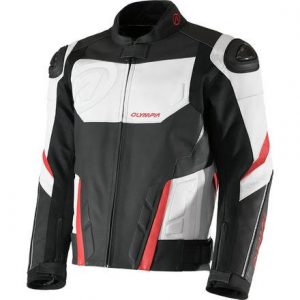
#Motovan
Covering coats. Options are too numerous to count. Similar to pants, textiles and leather are the two main groups. They also have similar cost/benefits. Hide slides better but doesn't always deal with weather without extra layers. Textiles may be more practical with venting, removable warmth, and waterproof layers as well as some increased options in colours. Coverage over or attachments to the pants can make sure protection is complete. Again, sit on a bike like yours, does the elbow armour dig in when holding onto the grips? Does the built-in back protector push against the back of your helmet? Standing in front of a mirror won't tell you that the collar chafes after 2 hours or that the cuffs pull themselves above the gloves when reaching for the controls. Some
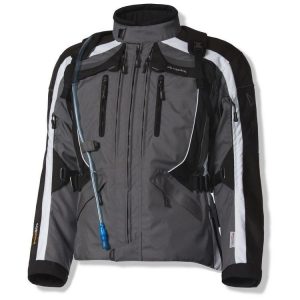
#Motovan
of the protection can be replaced, but ideally that should be for making the gear better, not for making it acceptable. Many coats offer adjustments to accommodate different shapes and sizes; make sure the coat you're trying on stays in that range. If the coat is too snug, that extra shirt or heated vest when it gets chilly may not fit. If it's too big, that same chilly draft or accompanying rain may find its way down the front and inside, a less than pleasant sensation. Not to sugar-coat it, but this is a key piece of gear

#Motovan
Getting a grip on gloves, covering the most fragile of the appendages. Hides slide, it's getting repetitive, but it's true. From shortly before you learn to walk, you start to learn to fall, and putting your hands out is instinct. Picture slapping the pavement with no motorcycle even around you. Less than pleasant. Forward motion doesn't change that for the better. The heels of your hand will take the biggest hit most of the time, added leather or armour here is key. In the same way ankle bones are subject to grinding when stuck between a bike and a road while moving, the knuckles can also find themselves in a difficult place, extra coverage across the back of them is also a good idea. The hands are the interface between you and your controls, thick gloves suited to working in Alberta winters can compromise feel and sensation needed for optimal control, but if you ride in cooler weather lightweight vented gloves can mean cold hands, and too cold means no feeling at all. Gauntlet style gloves, where above the wrist extends up the forearm can ensure maximum protection as well as security as this type will most often stay put on contact with the ground and keep elements out. Good wrist closures are key either way, as if you can slip them on, the road will slip them off. Get a grip on a good set and gloves will do much more than just keep your hands warm.
Topping it off with helmets. The AMSS will always promote a full face style helmet. The protection from the majority of helmet impacts is on the lower front sides of the face and jaw. This means a full face helmet simply protects better than any other style, from impacts as well as weather and other environmental issues. And as mentioned now to the point of being annoying, fit is the most important, and in this case, the most difficult to get right. Having knowledgeable staff at either a shop or at the annual motorcycle show can make all the difference in the world here. Different price ranges can include different accessories and finishes, but these would just be
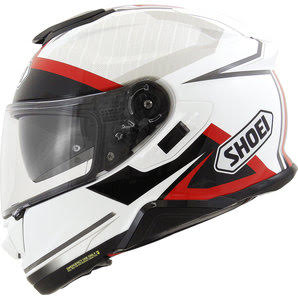
#Motovan
icing on the cake. If a $700 helmet does not fit well it is not able to do the job as effectively as a $200 helmet that seems to have been made for your head, you have literally wasted $700. The minimum standard to be road legal in the Province of Alberta is the Department of Transportation certification or DOT. There are additional organizations that perform tests and provide certification beyond DOT including but are not limited to the SNELL Foundation (SNELL) and the Economic Commission for Europe (ECE). These standards may be required for participating in some events such as racing or by some organizations. These standards may effect your choices, but unless required, fit should still be the priority. Different head shapes are either accommodated by additional padding, or various helmet shape designs, this is where knowledgeable staff can steer you right. Keeping a visor clean and scratch free means all important vision is not impaired. In addition to face and head impact and environmental protection, make sure to remember hearing protection. It is generally recognized that at the slower speeds in town additional hearing protection is not needed, but anytime highway speeds are considered, hearing protection is recommended. Not only do items like ear plugs stop things like permanent hearing loss and prevent conditions such as tinnitus, they can also reduce fatigue. Riding without for extended periods will cause some level of fatigue and this can directly effect the safety of both a rider or passenger. Make sure every ride is capped off with a good, well fitting, full face helmet.
For more information, please click here to see our video podcast on gear head to toe!
